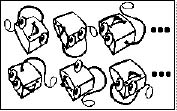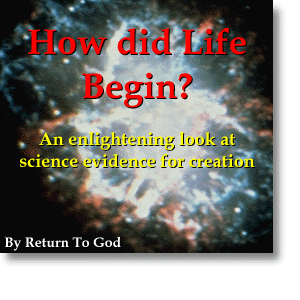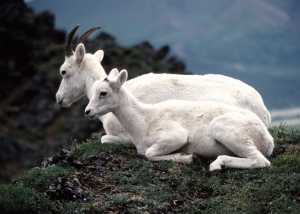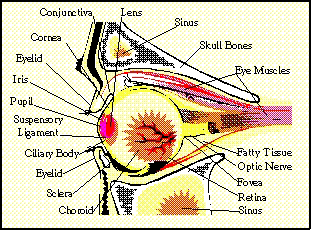Can Life
Emerge From Non-Living Matter?
No one has ever observed the creation of life from
non-living matter, or spontaneous generation. Even given ideal laboratory
conditions, scientists haven't been able to create life from non-living matter. Life has
been found only to come from life. This has been seen so consistently that it's called the
Law of Biogenesis.
Even if scientists could demonstrate spontaneous
generation, it's unlikely that life on earth began this way. Two basic components of life,
proteins and DNA, have characteristics that make their spontaneous generation unlikely.
Proteins couldn't have evolved if the early earth had oxygen in its atmosphere, because
the parts that make up proteins, amino acids, can't join in the presence of oxygen.
There had to be oxygen in the atmosphere, however. Without oxygen, there could be no ozone
in the upper atmosphere and without the ozone layer, the sun's ultraviolet radiation would
quickly destroy life. How then, can evolution explain both ozone and life?
Scientists have also found that the long chains of
amino acids necessary for life cannot be formed in water. This fact seriously impacts the
theory that life began in "the waters of some unknown seacoast."
The creation of DNA, the basic building block of
life presents an interesting evolutionary problem. DNA cells contain thousands of genes
that direct the functioning of living beings, including inherited characteristics, growth,
organ and system structure. The DNA for each species is unique. Certain protein molecules
or enzymes must be present for DNA to replicate, however those enzymes can only be
produced at the direction of DNA -- the DNA itself has the blueprint for the specific
enzymes it needs to replicate. Each depends on the other and both must be present for
replication to take place. How evolution could explain this has never been answered. |
How Was
the First Living Molecule Formed?
Evolutionists think that the early earth contained a
primordial "soup", consisting of all the components necessary for life. Through
random processes, the components combined in exactly the right way to form the first
living organism. Mathematical probabilities show that for all practical purposes, it is
impossible for complex living systems that consist of many inter-relating parts to come
about through random processes. Let's look at the mathematical chances for life to come
about in this way.
Probabilities Show Random Processes
Cannot Create Life
The most basic type of protein molecule that can be
called "living" has 400 linked amino acids, each composed of 4-5 chemical
elements. Each chemical element consists of a unique combination of protons, electrons and
neutrons. To simplify our calculations, let's look at the probability of chance formation
of an even simpler system, one that would contain only 100 elements.
We'll assume that all the necessary components were
readily available in the "soup" and that the components had to come together in
the right order to form a functioning system. Let's call our 100 element system
"Fred".

All the elements that make up "Fred" would
have to combine in the correct order to get a functioning "Fred". It's likely
that most of the possible combinations of the components would have to be tried before
"Fred" was formed. |

The gray box describes the procedure for calculating
probabilities. The probability of chance formation of "Fred" would be 1 in 100
factorial (or 1 x 2 x 3 x 4...x 99 x 100) or 1 in approximately 10158 (1 followed by 158
zeros). To get an idea of how large this number is, there are only 1080 (1 followed by 80 zeros)
electrons in the universe.
Insufficient Time For Creation Of Even
Simplest Organisms
Evolutionists claim that the evolutionary process
occurred over billions of years, so they feel there was plenty of time to make all the
necessary trial combinations and eventually get the correct ones. Let's test this theory
for "Fred".
Astronomers estimate the universe to be less than 30
billion years old, which is 1018 seconds. Let's assume that it takes a billionth of a second
for components to combine to form a trial 100 component "Fred". Let's also
assume that the number of electrons in the universe, 1080, is representative of the
number of basic components available for trial combinations of "Fred". This
would allow 1078 trial combinations of 100 component "Fred" to occur at a
time. With these assumptions, from the origin of the universe until today, 10105 trial
combinations could be made (1018 x 109 x 1078). Unfortunately, to be sure to get a functioning
"Fred" we would need 10158 combinations. The chance of one of our 10105 combinations
being the correct, functioning "Fred" is approximately one chance in one hundred
million billion billion billion billion billion (1 in 1053). It would take over
three billion billion billion billion billion billion billion years to try all the
possible combinations to be sure to create Fred. Written out, that's over 3, 000, 000,
000, 000, 000, 000, 000, 000, 000, 000, 000, 000, 000, 000, 000, 000, 000, 000, 000, 000,
000 years.
 There hasn't been nearly enough time to create even simple
"Fred" in the universe's supposed 30,000,000,000 years of existence! There hasn't been nearly enough time to create even simple
"Fred" in the universe's supposed 30,000,000,000 years of existence!
|

 Is this really the way it
happened?
Is this really the way it
happened? 

 There hasn't been nearly enough time to create even simple
"Fred" in the universe's supposed 30,000,000,000 years of existence!
There hasn't been nearly enough time to create even simple
"Fred" in the universe's supposed 30,000,000,000 years of existence!

 Textbooks say the light colored moth evolved into the dark colored
moth during this time. Is this evolution? No new species resulted, just a variation
within the species because of natural selection, or survival of the fittest.
Textbooks say the light colored moth evolved into the dark colored
moth during this time. Is this evolution? No new species resulted, just a variation
within the species because of natural selection, or survival of the fittest.


